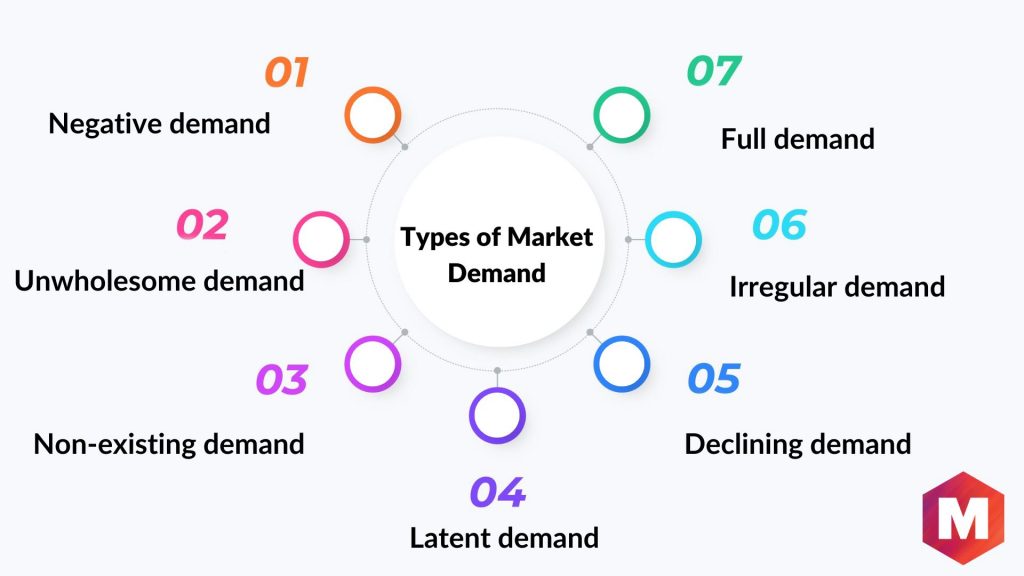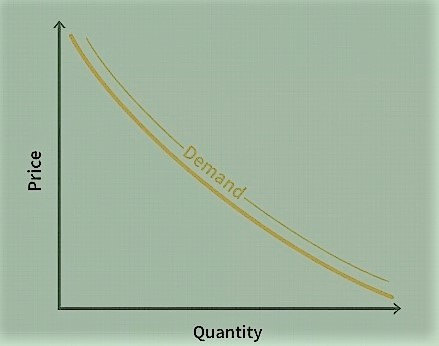Understanding market demand is crucial for businesses, as it helps gauge the level of interest in a product at a specific price. By considering market demand, companies can ensure they have the right amount of inventory to meet customer needs and optimize their profits.
The total market demand businesses face today is constantly changing, and it can be difficult for businesses to stay on top of the ever-shifting landscape. Keeping ahead of market demand requires a good understanding of your customer base, their needs, and their preferences.
Table of Contents
What is Market Demand?
Market demand refers to the overall amount of a product or service that people are willing and able to buy at a given price in a specific market. It reflects the combined interest and buying capacity of potential customers.
It is the number of units demanded by the total number of customers in the market. Thus the more popular a company is, the more will be the market demand for its products & the more will be the number of units demanded by the customers in the market. The market price is determined at the point of market equilibrium, where market demand meets the supplier’s output, creating a balance that benefits both consumers and producers.
We should not confuse market demand with market potential. The market potential is the total number of potential customers in a particular market. However, market demand is the actual demand for the product in the market. The following examples will help you grasp the concepts and relevance of market demand better-
Examples of Market Demand
1) Market demand for a particular product or service
Market demand can be influenced by a variety of elements, such as the introduction of new products or services, technological advances, and shifts in consumer behavior. One salient example is streaming services: these have seen exponential growth due to both advancing technology and ever-changing customer expectations. You may check such market demands via surveys, focus groups, or online forums.
2) Market demand for e-commerce platforms
In recent years, there has been a surge in the demand for e-commerce platforms due to high interest in the newest fashion lines, lifestyle items, and gadgets. By keeping an eye on the demand trends across geographical regions, e-commerce outlets can have a better idea of what their customers are looking for. With this knowledge at hand, businesses can benefit from increased sales opportunities.
3) Checking Market demand at the local level
To get a better grasp of the market demand for your product or service, look no further than your neighborhood. Consider doing some surveys to learn what products and services are trending with local customers. This way, you’ll be able to tell if there is an unmet need within the community or whether it’s already saturated with similar offers.
Why is Market Demand Important?
Any company which takes part in manufacturing has limited manufacturing potential. If it manufactures too much material then it is wasting working capital and also spending a huge amount to manage the inventory. Any company would like to keep costs under control and match customer demand at all times. This is why determining the market demand is very important for any company.
Unveiling a new product or service? Market demand is essential to examine and consider, as it enables corporations to fulfill their customers’ desires. Additionally, researching market demand can yield the following advantages –
1. Customer satisfaction: Knowing how much of their products and services the market desires can make a company successful by allowing them to swiftly meet customer needs. Being able to supply precisely what customers want in abundance produces satisfaction that leads to return business, increasing revenue for the company. Calculating market demand helps businesses accomplish this goal with ease.
2. Business opportunity: By closely tracking the market demand and consumer practices inside a certain marketplace, companies can better comprehend their customers’ desires. This involves hearing out clients and designing products to fit those needs.
3. Production and customer approach: By examining the pulse of customer demand, businesses can devise tailored and customized products to meet their customers’ needs while connecting with them on a deeper level. Studying market trends helps companies form effective strategies to reach their target market more easily.
4. Cost-effective methods: To create a successful and profitable business, it is essential to calculate the market demand for your product or service to prevent overproduction. By doing this, businesses can ensure that they can meet customer expectations and generate maximum profit from their products and services.
Types of Market Demand
1) Negative demand
Negative demand is an economic term that refers to when a product or service fails to meet the expectations of businesses, leaving customers unable and/or unwilling to purchase it. As such, companies must rethink their marketing strategy to reach a wider audience and make their products more available. This way they can ensure people are aware of what goods and services they offer so that consumers can take advantage of them if desired.
2) Unwholesome demand
When consumers wish for and can purchase a product that may be potentially dangerous, it is known as unwholesome demand. Companies must create safer products by abiding by safety laws and federal regulations. Additionally, businesses should take the extra step of educating customers on how to utilize their products responsibly so that customers are better protected from harm.
3) Non-existing demand
Non-existing demand is a common occurrence when customers do not purchase any of a certain commodity. Such instances may result from people’s minimal resources or acquisition of other merchandise. Companies can avert this by initiating in-depth market research, which unveils essential consumer data such as preferences for buying goods and location information.
4) Latent demand
Unrecognized consumer demand can arise in the absence of a specific product. Thanks to technological advancements and customer tracking tools, marketers are now better able to identify latent demands before they become an issue for businesses. By utilizing these powerful technologies, marketing teams have achieved unprecedented insights into patterns and customer needs so that products may be produced ahead of time to satisfy their desires.
5) Declining demand
When customers’ need or appetite for a product continuously decreases, we understand it as declining demand. To manage this type of demand, businesses must stay up to date with market trends and enhance their products accordingly. Collecting customer feedback is an essential tactic in producing items that satisfy the marketplace’s needs.
6) Irregular demand
Irregular demand, or the unpredictable shifts of customers’ purchasing power and needs for goods and services, can be a difficult challenge to overcome. However, with an altered market strategy that includes appropriate promotion tactics and customer acquisition strategies, businesses can effectively manage these fluctuations in consumer desire. Economic experts assert that by making simple modifications to their marketing approach companies may vastly improve how they respond to irregular demand.
7) Full demand
Every business dreams of achieving full demand, where its supply meets the requisite consumer demand. To make this happen, companies must dedicate time and effort to understanding who makes up their target market and craft a marketing strategy that captivates these audiences. When businesses are successful in doing so, they will notice sales occurring at the same rate products or services become available—resulting in optimal profitability for themselves.
How to Calculate Market Demand?
There are two ways to calculate the market demand for any product
1) Product-level market demand
If you already know the geographic market which you are going to Target, then you can use the product level market demand method. In product-level demand, the market is broken down in terms of the total product that exists in the market. The market demand for each product is calculated and found out via market sources or market research. This research then gives us a total estimation of the demand for the product. Naturally, it also gives us an estimation of the market potential as well.
For more clarity, read the article on the Market demand curve.
For example, if I was going to launch a brand new shampoo in the market I will have to calculate the market demand and the market share of all the shampoos being sold by P&G and HUL. I would do a market research study and find out what was the total industry sales for these brands. I would also like to find out what was the product line sales for this particular brand.
For instance, within the shampoos category, anti-dandruff shampoo, as well as conditioners, are two different products and two different product lines. To truly find out the market demand for shampoos, I will have to find out the individual market demand for conditioners as well as anti-dandruff shampoo so that I can find out a net measure of the available market for these products.
So any industry that you are in if you want to find out the market demand for a particular product you just have to do a market research study on the number of units selling for all the brands and this will give you a fair example of the market demand for the product.
2) Geographic level market demand
The Geographic level market demand is very commonly used by a company that is planning on expansion to Foreign regions. In this type of estimation of market demand, the company wants to know the demand for a particular product in a specific geography.
Even in this geographic type of demand, the company conducts a market research study for the number of units being sold in the market for a particular unit or SKU. In such cases, the company might already be present in the target market or it may be planning to establish itself in the target market.
So if I was in the Ice cream business and I wanted to start a new brand of ice cream in a new market, then I would calculate all the other ice creams and their turnover in the market. This becomes the market potential. From that, I will calculate, the ice cream which is closest and nearest in value to my brand. And the turnover of that ice cream is the possible market demand that I can achieve.
Alternatively, In the cement industries, manufacturing drives the sale of the cement brand. If the cement of one brand is not available, many buyers will buy the cement of another brand because it is a necessity. As a result, the market potential is almost equivalent to the demand in the market for the product. The company which manufactures the most caters to the demand at all times and therefore grows the fastest.
How to Find Market Demand
By understanding the demands of a market, entrepreneurs can gain valuable insight into which fields are most lucrative to venture into with their online business. Some of the methods you can use to research marketing demand are
1) Surveys
When you survey potential and current customers, it can provide invaluable insight into what they desire – so that your product or service offerings meet their demands.
2) Experiments
Market experiments provide entrepreneurs the liberty to prove their theories and assess the outcomes in real time. This enables them to make adjustments if necessary, ensuring that they are always making progress toward success.
3) Observations
Examining customer behavior, analyzing competitive forces, and scouring industry publications can all offer valuable insights into the marketplace.
4) Data Analysis
By deciphering data obtained from a variety of sources, market research can help to reveal customers’ wants and needs.
5) Using SEO Tools
Search engine optimization (SEO) tools can be used to uncover what people are searching for online. Knowing what people are looking for could enable businesses to create products or services that they know will be in demand.
6) Using social listening tools
Social listening tools help businesses to gain insight into what is being discussed on social media, and this can be used to understand consumer preferences. Knowing what people are talking about could enable businesses to create products or services that they know will be in demand.
What’s a Market Demand Curve?
Market demands are revealed in the market demand curve – a graphical illustration of how much buyers are ready to purchase at various prices. This graph demonstrates the transformation that occurs when the price fluctuates, demonstrating an increase or decrease in consumer requirements for a particular product.
The market demand curve is a representation of product demand based on pricing. To create the market demand curve, every individual input regarding customer desire must be graphically illustrated in a line chart.
Moving along the y-axis, you will discover a variety of price points. On the x-axis, you will find how many times that particular product was bought within a certain timeframe at each cost point. On the contrary, supply curves have an upward slant. As with any free market, there will always be peaks and troughs in terms of demand and supply.
Individual Demand vs Market Demand
Individual and market demand is quite different. When you think of individual demand, consider a person or household. Market demand is the collective preferences and interests among many people in one segment. Market demand is the result of individual demands, like a person’s preferred flavor and brand of food or car.
To illustrate this concept further, think about how many people might be demanding a specific type of car or cuisine; that’s an example of market demand. On the other hand, consider someone who wants one certain model with particular features – that would constitute an individual demand.
Advantages of Calculating Market Demand
1. Customer Expectations – One of the most important advantages of calculating market demand is the fact that your customer expects you to keep the product in stock for him. If I want to buy a particular brand of soap and the soap is not available in the local market (because of a wrong demand calculation) then I will give up the brand and search for something else. As a result, the soap company has lost a hard-earned customer to some other brand. If the soap company had estimated market demand, then they would have had the soap manufactured and delivered to the retailer so that the customer could purchase it when he requires it.
2. Opportunity loss is avoided – There is a huge opportunity loss if the market demand is calculated incorrectly. Continuing the above example, if a company does not calculate the market demand correctly then it will not produce the right amount of units that are required in the market, and as a result, it will lose a lot of revenue that it could have generated from the market.
3. Cost savings – There is also a negative side to overestimating market demand. If the market demand was a hundred units and I have manufactured 200, then I have invested too much amount in the product which was not needed. I have reduced my working capital and at the same time, I would be paying a good amount of money for the warehousing of the products which have been overproduced. By doing the correct demand measurement we can save a lot of such costs.
4. Focused approach – Measuring the market demand also helps companies focus on the target market. If a company has 10 different products and the market demand is high for two or three products, then the company can have a focused approach and produce these two or three units in huge volumes and also push them in the market.
Conclusion!
The above was the complete explanation of what is market demand, the advantages of market demand calculation, market demand function, market demand research, examples of market demand as well as the ways to calculate market demand.
To sum up, understanding the demand in the market is critical to launching a new product or service with success. Marketers should research potential customers and their needs as well as identify overall market trends and current conditions before setting sail on any project.
Calculating the quantity demanded gives them insight into possible sales figures and revenue streams, allowing marketers to make informed decisions that will steer them toward victory!
Liked this post? Check out the complete series on Marketing




how we can establish our industrial organisation(chart) and its importance